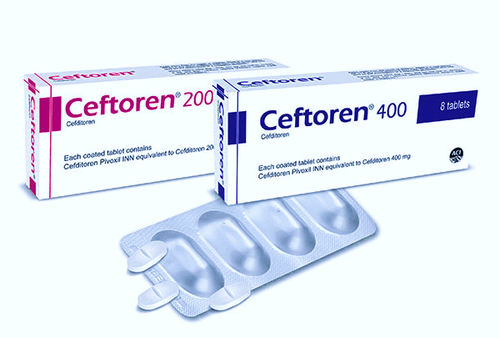This is an automatically translated article.
Cebest 200 is indicated for the treatment of mild to moderate infections caused by susceptible strains of bacteria. So what is Cebest and how should it be used?1. What is Cebest?
Cebest 200 is an antibiotic containing 200 mg of cefpodoxime in the form of cefpodoxime proxetil, the drug is made in the form of film-coated tablets. There is also a form of Cebest 50mg with the main ingredient being cefpodoxime 50mg.
2. Indications of the drug cebest
Cebest is indicated for the treatment of mild to moderate infections caused by susceptible strains of bacteria:
Upper respiratory tract infections: Acute sinusitis caused by bacteria Haemophilus influenzae (including strains produced by strains of Haemophilus influenzae). beta-lacta-mase), Streptococcus pneumoniae and Moraxella catarrhalis; pharyngitis and/or tonsillitis caused by Streptococcus pyogenes; acute otitis media caused by Streptococcus pneumoniae (other than penicillin-resistant strains), Streptococcus pyogenes, Haemophilus influenzae (including beta-lactamase-producing strains) or Moraxella (Branhamella) catarrhalis (including beta-lactamase-producing strains) Lower respiratory tract infections: Acute exacerbation of chronic bronchitis caused by S. pneumoniae, H. influenzae (non-beta-lactamase-producing strains) or M. catarrhalis; community-acquired pneumonia caused by S. pneumoniae or H. Influenzae (including beta-lactamase-producing strains) For the treatment of mild to moderate upper respiratory tract infections (pharyngitis, tonsillitis) caused by Streptococcus pyogenes susceptible, cefpodoxime is an alternative to amoxicillin or amoxicillin plus potassium clavulanate used ineffectively or uncomplicated Urinary tract infections caused by bacteria Escherichia coli, Klebsiella pneumoniae, Proteus mirabilis, Staphylococcus saprophyticus Gonorrhea not Complicated and disseminated N. gonorrhoea with or without penicillinase Uncomplicated skin infections caused by Staphylococcus aureus (including penicillinase-producing strains) or Streptococcus pyogenes
3. How to take Cebest
Adults and children over 12 years: orally 100 - 400 mg x 2 times/day, 12 hours apart
Acute exacerbation of chronic bronchitis or community-acquired mild to moderate pneumonia: 200 mg x 2 times / day, each time 12 hours apart, treatment for 10 or 14 days.
Pharyngitis and/or tonsillitis due to Streptococcus pyogenes infection: 100 mg x 2 times/day, each time 12 hours apart, treat for 5-10 days
Mild and moderate skin and skin tissue infections that have not resolved control: 400 mg x 2 times/day, 12 hours apart, treatment for 7-14 days
Mild and moderate urinary tract infections, uncomplicated: 100 mg x 2 times/day, each time 12 hours apart, treatment for 7 days
Uncomplicated gonorrhea: Take a single dose of 200 mg or 400 mg of cefpodoxime, then continue treatment with oral doxycycline to prevent Chlamydia infection.
Elderly: The same dose as adults.
Children from 2 months to 12 years: Oral 10 mg/kg/day, divided into 2 times, 12 hours apart (maximum dose 400 mg/day).
Children from 2 months to 6 years old: use granules mixed with oral suspension or as prescribed by a doctor
Acute otitis media: 5 mg/kg (up to 200 mg) x 2 times/day, each time 12 hours apart, orally for 5 days
Pharyngitis and tonsillitis caused by Streptococcus pyogenes: 5 mg/kg (up to 100 mg) x 2 times/day, 12 hours apart, for 5-10 days
Acute sinusitis : 5 mg/kg (up to 200 mg) x 2 times/day, 12 hours apart, for 10 days.
Community-acquired pneumonia, acute exacerbation of chronic bronchitis: 200 mg x 2 times/day, 12 hours apart, treatment for 14 days and 10 days respectively.
Uncomplicated urinary tract infections: 100 mg x 2 times / day, each time 12 hours apart, treatment for 7 days.
Hepatic impairment: no dose adjustment is required.
Renal impairment: If creatinine clearance is greater than 40 ml/min, no dose adjustment of cefpodoxime is required.
How to take the drug: Cebest should be taken with food to increase the absorption of the drug from the gastrointestinal tract.
4. Contraindications of Cebest
Patients with hypersensitivity to cefpodoxime, other cephalosporins or any of the excipients. Patients with hypersensitivity to other penicillins or beta-lactam antibiotics.
5. Undesirable effects of the drug Cebest
Blood and lymphatic system disorders (Rare): decreased hemoglobin, thrombocytopenia, thrombocytopenia, leukopenia and eosinophilia Nervous system disorders (Uncommon): Headache, dizziness, sensation unusual Ear abnormalities and hearing disorders: tinnitus Gastrointestinal disorders (Common): Increased stomach pressure, nausea, vomiting, abdominal pain, flatulence, diarrhea. Metabolism and nutrition disorders: Loss of appetite Hepatobiliary disorders (Rare): Transient elevation of liver enzymes ASAT, ALAT and alkaline phosphatase and/or bilirubin. Skin and subcutaneous tissue disorders (Uncommon): Hypersensitivity to skin and mucosal reactions, rash, urticaria, pruritus Infections and parasitic infections: prolonged use of Cebest may lead to Overgrowth of non-susceptible organisms (Candida and Clostridium difficile) Here is all the important information about Cebest. Using the right purpose and dose will help bring the best treatment effect to the patient.
Please dial HOTLINE for more information or register for an appointment HERE. Download MyVinmec app to make appointments faster and to manage your bookings easily.













